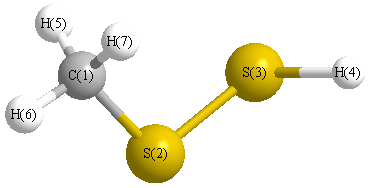Vibrational Frequencies calculated at HF/6-31G**
| Mode Number |
Symmetry |
Frequency
(cm-1) |
Scaled Frequency
(cm-1) |
IR Intensities
(km mol-1) |
Raman Act
(Å4/u) |
Dep P |
Dep U |
|---|
| 1 |
A |
3315 |
2992 |
10.27 |
62.23 |
0.75 |
0.86 |
| 2 |
A |
3298 |
2977 |
8.38 |
88.31 |
0.75 |
0.86 |
| 3 |
A |
3208 |
2895 |
25.91 |
124.30 |
0.02 |
0.04 |
| 4 |
A |
2869 |
2590 |
10.96 |
159.61 |
0.34 |
0.51 |
| 5 |
A |
1610 |
1453 |
8.85 |
13.50 |
0.73 |
0.84 |
| 6 |
A |
1592 |
1437 |
8.14 |
19.54 |
0.75 |
0.86 |
| 7 |
A |
1499 |
1353 |
7.98 |
1.50 |
0.43 |
0.60 |
| 8 |
A |
1085 |
979 |
10.19 |
5.30 |
0.49 |
0.66 |
| 9 |
A |
1077 |
972 |
1.88 |
5.29 |
0.75 |
0.86 |
| 10 |
A |
994 |
897 |
11.16 |
20.76 |
0.71 |
0.83 |
| 11 |
A |
769 |
694 |
1.84 |
20.78 |
0.40 |
0.58 |
| 12 |
A |
561 |
506 |
1.00 |
35.77 |
0.27 |
0.42 |
| 13 |
A |
329 |
297 |
22.29 |
8.47 |
0.75 |
0.86 |
| 14 |
A |
262 |
237 |
0.11 |
4.75 |
0.61 |
0.76 |
| 15 |
A |
190 |
172 |
0.61 |
0.04 |
0.75 |
0.86 |
Unscaled Zero Point Vibrational Energy (zpe) 11328.5 cm
-1
Scaled (by 0.9026) Zero Point Vibrational Energy (zpe) 10225.1 cm
-1
See section
III.C.1 List or set vibrational scaling factors
to change the scale factors used here.
See section
III.C.2
Calculate a vibrational scaling factor for a given set of molecules
to determine the least squares best scaling factor.
Charges, Dipole, Quadrupole and Polarizability
Charges from optimized geometry at HF/6-31G**
Charges (e)
| Number |
Element |
Mulliken |
CHELPG |
AIM |
ESP |
| 1 |
C |
-0.489 |
|
|
|
| 2 |
S |
0.035 |
|
|
|
| 3 |
S |
-0.087 |
|
|
|
| 4 |
H |
0.068 |
|
|
|
| 5 |
H |
0.164 |
|
|
|
| 6 |
H |
0.156 |
|
|
|
| 7 |
H |
0.153 |
|
|
|
Electric dipole moments
Electric dipole components in Debye
(What's a Debye? See section
VII.A.3)
| |
x |
y |
z |
Total |
| |
-1.155 |
1.454 |
1.013 |
2.115 |
| CHELPG |
|
|
|
|
| AIM |
|
|
|
|
| ESP |
|
|
|
|
Electric Quadrupole moment
Quadrupole components in D Å
| Primitive |
|---|
| | x | y | z |
|---|
| x |
-31.463 |
-0.518 |
2.060 |
| y |
-0.518 |
-35.713 |
0.746 |
| z |
2.060 |
0.746 |
-33.667 |
|
| Traceless |
|---|
| | x | y | z |
|---|
| x |
3.227 |
-0.518 |
2.060 |
| y |
-0.518 |
-3.148 |
0.746 |
| z |
2.060 |
0.746 |
-0.080 |
|
| Polar |
|---|
| 3z2-r2 | -0.159 |
|---|
| x2-y2 | 4.250 |
|---|
| xy | -0.518 |
|---|
| xz | 2.060 |
|---|
| yz | 0.746 |
|---|
|
Polarizabilities
Components of the polarizability tensor.
Units are
Å
3 (Angstrom cubed)
Change units.
| |
x |
y |
z |
| x |
8.478 |
0.472 |
0.221 |
| y |
0.472 |
5.414 |
0.124 |
| z |
0.221 |
0.124 |
4.803 |
<r2> (average value of r
2) Å
2
| <r2> |
102.491 |
| (<r2>)1/2 |
10.124 |
